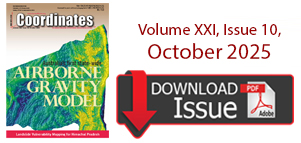| GNSS News | |
GNSS
Galileo nominal service restored
The Galileo Service was affected from Dec 14, 00:00 UTC by an anomaly in the time determination function of the ground segment of the system.
This resulted in signals flagged as MARGINAL (SISA=NAPA) for all satellites. During this period, pseudorange errors in excess of nominal performance were experienced by user receivers.
The system was reconfigured and restored to a nominal situation as of Dec 14, 06:00 UTC. A NAGU will be published shortly with the exact chronology of the event. www.gsc-europa.eu
NavIC gets IMO recognition
The Indian Space Research Organisation (Isro) said that the International Maritime Organisation (IMO) has recognised NavIC as a component of the World-Wide Radio Navigation System (WWRNS). This recognition was awarded in the 102nd meeting of Maritime Safety Committee of IMO (MSC-102).
In April 2020, NavIC L5 was incorporated in the Radio Technical Commission for Maritime Services (RTCM) standard 10403.3 for differential Global Navigation Satellite System (GNSS) applications. These developments will enable the utilisation of NavIC in the fields of maritime navigation, surveying and others. www.business-standard.com
Otago’s School of Surveying reaches the top of the world
A new accurate height of Mount Everest has been announced to the world and a University of Otago academic has been instrumental in supporting the Nepalese surveyors achieve that ambition.
Geodesist Dr Chris Pearson of Otago’s School of Surveying led New Zealand’s MFAT Head of Mission Fund project by providing technical expertise and training to Nepal’s Department of Survey to undertake the work themselves.
“As Mount Everest holds immense national pride for the Nepalese, it has been immensely gratifying to support local surveyors reach this goal themselves and also contribute to the development of the country,” Dr Pearson says. The new height of 8,848.86m has been announced in a joint statement by Nepal and China, marking a small increase from the commonly referenced height of 8,848m that was established by the Survey of India in 1954, the year after the late Sir Ed Hillary summited the world’s highest peak.
Dr Pearson says that due to tectonic activity such as the significant 2015 Gorkha Earthquake, the height of Everest is constantly changing and using the latest technologies allowed the new accurate measurements to be made. He has led New Zealand’s involvement in surveying projects in Nepal since the 2015 earthquakes which caused massive horizontal and vertical ground displacement across the land-locked country, resulting in significant inaccuracies in coordinates and geodetic databases.
Dr Pearson says a complication of determining the height of Everest is the summit is an ice cap that can change due to seasonal accumulation and melting, and therefore measurement of the height of the rock below this cap is important.
“The new measurement is by far the most accurate sea-level height for Sagarmatha due to the levels of technology used, and the new models will also make it easier to measure the exact heights of other mountains in Nepal using modern GPS techniques.” www.otago.ac.nz
India seeks bids for manufacture of 10 lakh homegrown NavIC chips
The Indian government has invited proposals for the manufacture of 10 lakh receiver chips that have GPS and NavIC, in an attempt to improve the overall signal availability of positioning systems, and increase the use of the indigenous positioning system.
In a bid titled, “Request for Proposal Design, Manufacture, Supply and Maintain Integrated NavIC and GPS Receivers,” the ministry has stated it wishes to use the NavIC integrated receivers for areas such as navigation on land, air and water, disaster management, vehicle tracking, location services on mobile phones. www.thequint.com
New Glonass satellites to cost four times more
Russia’s next-generation Glonass-K2 navigation satellites that will be launched into orbit starting from next year will cost four times as much as the older, Glonass-M, models currently in operation, according to the Russian space agency, Roscosmos.
The Glonass-K2 satellites appear to be twice as expensive as the Glonass-K1 model, which, in turn, is twice as expensive as the Glonass-M satellite. www.urdupoint.com
GPS III SV04 receives operational acceptance
Global Positioning System III Space Vehicle (SV) 04 received United States Space Force’s Operational Acceptance approval on Dec. 1- marking yet another significant milestone for the GPS III program, Space and Missile Systems Center and USSF. It is the fourth GPS III satellite delivered into the operational constellation in the past 12 months and the second in the past three months.
Additionally, this is the first GPS III vehicle delivered to the warfighter through an expedited satellite control authority transfer process, which cuts ten days off the previous operational acceptance timeline.
SV04 was launched on a SpaceX Falcon 9 Block 5 vehicle on Nov. 5. The Air Force has been flying 31 operational satellites for years in order to ensure the United States’ commitment to have 24 operational GPS satellites available 95% of the time. spaceforce.mil












 (No Ratings Yet)
(No Ratings Yet)






Leave your response!